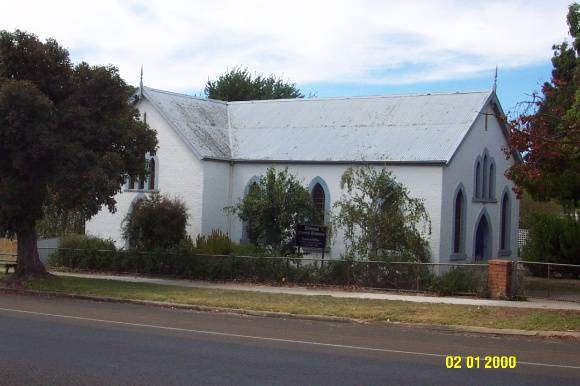| Back to search results » | Back to search page » |
|
METHODIST CHURCH (FORMER)
Other NamesMETHODIST CHURCH & MANSE (FORMER) , PEDEN'S FUNERAL PARLOUR , FORMER METHODIST CHURCH Location177 HENTY STREET, CASTERTON, GLENELG SHIRE LevelRecommended for Heritage Overlay |
|
Statement of Significance
What is Significant?
The first section of the former Wesleyan Methodist Church, Henty Street, Casterton was built in 1877. Within ten years a major extension added a new nave and converted the original into transepts. No architect, designer or builder has been linked with the construction. The building is a very simple interpretation of the Gothic Revival style, a style which the first Methodists had eschewed. Services had been held at Casterton from at least the early 1860s when Ministers visited from Portland and Hamilton. The Merino Circuit, which included Casterton and beyond, was formed in 1867 with the Rev. R. M. Hunter as the first Minister. Casterton appears to have been a strong and committed congregation, with the usual hard-working dedicated individuals and inducing at least two important callings to the ministry. With Casterton beginning to eclipse Merino, a parsonage was built next door in 1891. A Sunday school, later extended but now demolished, and a tennis court were built before World War 2. A new vestry and tennis pavilion were built after WW2, using bricks from the Merino parsonage. The church became redundant when the Methodist and Presbyterian congregations joined to form the Casterton Uniting Church congregation in the late 1970s. The building was purchased by Pedens Funeral Directors P/L and converted into a funeral chapel. The building was altered internally and painted externally. It retains a fair degree of integrity and is in good condition. The tennis court, pavilion and timber store survive at the rear.
How is it Significant?
Pedens Funeral Directors, the former Wesleyan Methodist Church, is of historical and architectural significance to the Glenelg Shire.
Why is it Significant?
Pedens Funeral Directors, the former Wesleyan Methodist Church and its setting are of historical significance for representing the early influence and importance of the Methodist Church in Casterton and the district generally. It demonstrates the dedication of the local congregation and clergy to establishing and consolidating religious order in the far Western District of Victoria, including cooperating with other denominations. It is of further historical significance as the continuous focus for the work of the members and ministers of the congregation of Casterton for over 100 years. The building is of architectural significance for its simple interpretation of the Gothic Revival style and as a comparison with other churches.
Group
Religion
Category
Church




